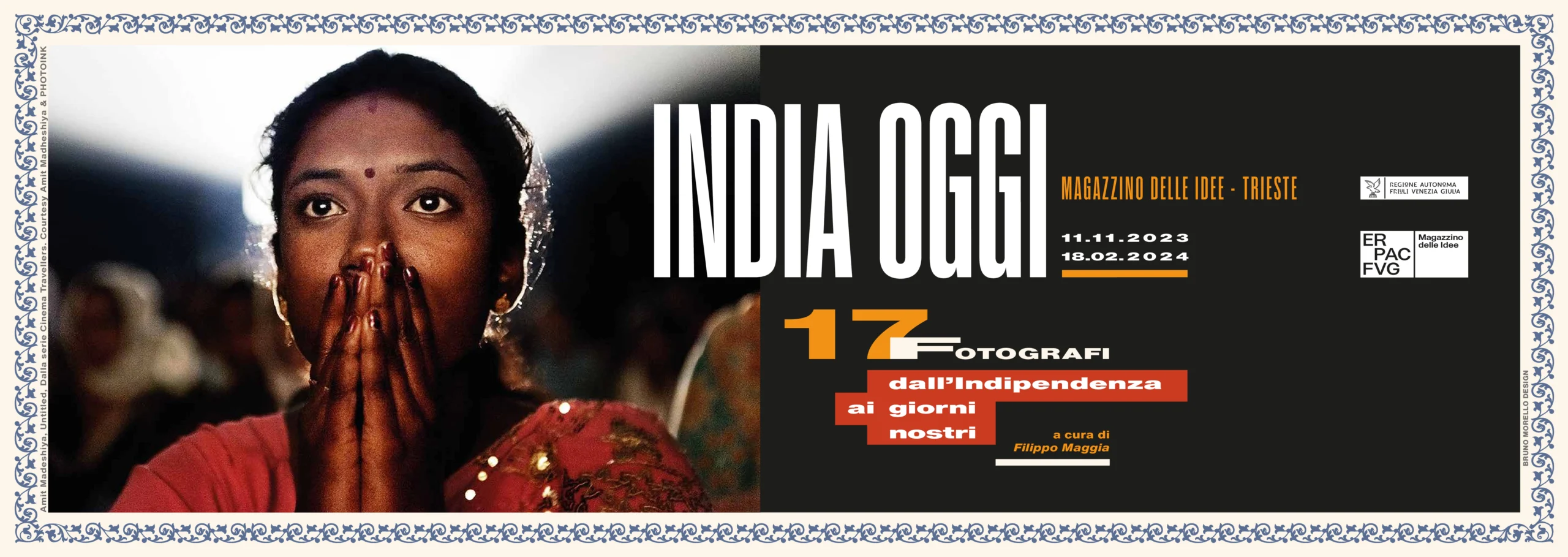17 photographers from Indipendence to the present day

From 11.11.2023 to 18.02.2024
The first exhibition to bring together and present seventy years of Indian photography in Europe in one large exhibition project comprising more than 500 works including photographs, videos and installations.
The exhibition
Through visual narratives, experiences, testimonies and investigations, India Today traces a social-historical path from Mahatma Gandhi and the decade immediately following independence from the British Empire in 1947 to the present day. From the post-colonial past to the affirmation among the major international economies, the exhibition bears witness to the radical transformation of which the Indian subcontinent is a protagonist, marked by an exponential development that has to reckon with profound contradictions and social inequalities. Capturing the multiple aspects of this evolution, between tradition and change, is the photographic gaze of seventeen artists in the exhibition:
Kanu Gandhi, Bhupendra Karia, Pablo Bartholomew, Ketaki Sheth, Sheba Chhachhi, Raghu Rai, Sunil Gupta, Anita Khemka, Serena Chopra, Dileep Prakash, Vicky Roy, Amit Madheshiya, Senthil Kumaran Rajendran, Vinit Gupta, Ishan Tankha, Soumya Sankar Bose, Uzma Mohsin.
Established authors and new protagonists of contemporary Indian photography, an increasingly attentive and profound interpreter of the present and the near future that characterise the Indian subcontinent.
“The process of sudden and unstoppable economic and industrial evolution that has been taking place in India since the end of the last millennium,” writes Filippo Maggia in his introduction to the catalogue, “is causing serious consequences, both social, such as issues of gender, identity and religion, and environmental. The inevitable depopulation of the countryside and rural areas, from the foothills of the Himalayas to the southernmost tip of Kerala, has led to the overcrowding of metropolises such as Mumbai, New Delhi or Calcutta, with a strong impact on the environment, sometimes even involving the coercive displacement of millions of people from one region to another. It is with these issues that Indian photography, now emancipated from the traditional image of the exotic, colourful India of Salgarian memory, is mainly concerned today”.
The exhibition presents the works of the 17 artists following a chronological order that advances through the decades, from the mid-twentieth century to the new millennium, leaving ample space for the works of contemporary authors. A narrative made through the images that the artists took while living the direct experience, of the moment consciously participated in and returned through photography, adopted in this case as a witness. Throughout the exhibition, each author is introduced by a statement describing the genesis and development of their work.
The exhibition is curated by Filippo Maggia, produced and organised by ERPAC – Ente Regionale per il Patrimonio Culturale del Friuli Venezia Giulia
The photographers
Kanu Ghandi: grandson of the Mahatma, portrayed him in the years when he professed civil disobedience and non-violent activism.
Bhupendra Karia:explores rural India post-independence, focusing on the social, political and environmental challenges the country faces.
Pablo Bartholomew: recounts his experience as a 20-year-old hungry for life between Delhi, the then Bombay, and Calcutta in search of investigations in difficult social circles.
Ketaki Sheth: collected the changing Bombay of the late 1980s and early 1990s with the building boom, the massive arrival of internal migrants, the contrast between tradition and change.
Sheba Chhachhi: an activist and chronicler of the Indian feminist movement, interprets the story of seven female activists in a ‘staged’ portrait.
Raghu Rai: unanimously considered one of the masters of Indian photography, he brings together four decades of Indian history, from the 1960s to 2000, in his work.
Sunil Gupta: presents, a kind of private diary, in which the rural India of his home villa forms the backdrop to his tormented existence.
Anita Khemka: with intensive work spanning two decades, followed the evolution of Laxmi, a very popular transgender activist in India, whose natural directness and genuineness she recounts.
Serena Chopra: attended the Majnu ka Tilla refugee camp for eight years, collecting images and sound testimony, writings and drawings made by Tibetan exiles.
Dileep Prakash:investigated post-colonial legacies with the aim of understanding how far the link between the two different cultures continues and how.
Vicky Roy: his work addresses one of the most topical dramas in Indian society, orphaned or abandoned children. He renders a picture of them full of life and hope with an appeal to be able to give them a future.
Amit Madheshiya: in his photographs he portrays the lost, astonished and enraptured faces of cattle breeders and farmers watching, for the first time, the screening of films under improvised tents of travelling cinemas.
Senthil Kumaran Rajendran: tells of the difficult co-existence between tigers and humans, against a background of population growth, new settlements and deforestation.
Vinit Gupta: his work focuses on ecology, and the struggles of populations threatened by industrial interests that disrupt their identity and traditions.
Ishan Tankha: witnesses the protests of the jal satyagrahis who are fighting against the construction of dams that would displace hundreds of thousands of people, and the adivasis who are fighting against the exploitation of their land rich in coal and iron.
Soumya Sankar Bose: through oral and video testimonies, he reconstructed the massacre in Marichjhapi, West Bengal, perpetrated by police forces against lower caste Bengali refugees in 1979.
Uzma Mohsin: she analyses the mechanisms and consequences of civil proposals in a country where dissent is considered equal to ‘disloyalty, anti-nationalism and sedition’, as she puts it.
Catalogue
Accompanying the exhibition is the catalogue India Today. 17 photographers from independence to the present day, edited by Filippo Maggia, published by Electa Photo.
Opening hours
Tuesday to Sunday 10.00 a.m. – 07.00 p-m.
closed on Monday
Special opening
8 and 26 December 2023, 1st and 6 January 2024
24 and 31 December closes at 02.00 p.m.
Tickets
Full price € 8,00
Reduced ticket € 5,00:
– 65 years old
– guys from 12 to not yet 18 years old
– students under 26 years of age
– differently abled
Free:
– children up to 12 years of age
– group leaders (1 per group)
– visiting teachers with pupils/students (2 per group)
– one accompanying person per disabled person
– ICOM members
– journalists with a valid National Order card on duty
Groups (min 10 pax – max 25 pax):
€ 5,00 each without guide
€4,00 each with guide (plus €50,00 for the guide)
The ticket office closes half an hour earlier
Information
email: info@magazzinodelleidee.it
phone +39 040 3774783
Social
Facebook: @magazzinoideetrieste
Instagram: @magazzinodelleidee
#magazzinodelleidee
Press office
Margherita Baleni
E-mail: margherita.baleni@battage.net
T +39 347 4452374
Alessandra de Antonellis
E-mail: alessandra.deantonellis@ddlstudio.net
T +39 339 3637388 T

